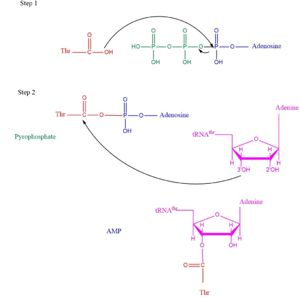User:Khadar Abdi/Sandbox1
From Proteopedia
(Difference between revisions)
| Line 1: | Line 1: | ||
==Threonyl-tRNA Synthetase/ligase== | ==Threonyl-tRNA Synthetase/ligase== | ||
| - | <StructureSection load=' | + | <StructureSection load='1NYQ' size='400' side='right' caption='Staphylococcus aureus threonyl-tRNA Synthetase bound to Threonyl-Sulfamoyl Adenosine' scene=''> |
| - | == Function/Mechanism == | + | == General Function/Mechanism == |
| - | '''Threonyl t-RNA Synthetase''' or '''Threonyl-tRNA ligase''' or '''TARS''' is class II '''Aminoacyl-tRNA synthetase''' enzymes. These enzymes primary function are to added the respective amino acid to the respective transfer Ribonucleic Acid (tRNA-AA) The main function of | + | '''Threonyl t-RNA Synthetase''' or '''Threonyl-tRNA ligase''' or '''TARS''' is class II '''Aminoacyl-tRNA synthetase''' enzymes. These enzymes primary function are to added the respective amino acid to the respective transfer Ribonucleic Acid (tRNA-AA) The main function of TARS is to add Threonine amino acid (Thr) to threonine specific tRNA (tRNA-thr) a necessity prep for the protein synthesis pathway. Below displays the overview of the Aminoacylation rxn. <ref>PMID:29305884</ref>[[Image:TARS_protein_rxn.jpeg |left|thumb|500px| '''Overall TARS protein rxn. Substrates includes Adenosine triphosphate (ATP), Threonine (Thr) and threonine specific transfer Ribonucleic Acid (tRNA-thr).''']] |
{{Clear}} | {{Clear}} | ||
| - | TARS adds amino acid to tRNA by a two-step mechanism. First the enzyme binds to both <scene name='78/786634/Threonine_amino_acid_2/2'>Threonine</scene> and <scene name='78/786634/Atp/1'>ATP</scene> in the catalytic domain to perform an adenylation reaction in which pyrophosphate is released as a byproduct. This is then follow up by a transferring Thr from Adenosine monophosphate molecule to 3'OH site of tRNA-thr. <ref>Lehninger, A. L., Nelson, D. L., & Cox, M. M. (2000). ''Lehninger principles of biochemistry.'' New York: Worth Publishers.</ref> | + | TARS adds amino acid to tRNA by a two-step mechanism. First the enzyme binds to both <scene name='78/786634/Threonine_amino_acid_2/2'>Threonine</scene> and <scene name='78/786634/Atp/1'>ATP</scene> in the catalytic domain to perform an adenylation reaction in which pyrophosphate is released as a byproduct. The image to the right displays the binding of adenylate product to the TARS enzyme (PDB entry [[1nyq]]). This is then follow up by a transferring Thr from Adenosine monophosphate molecule to 3'OH site of tRNA-thr. <ref>Lehninger, A. L., Nelson, D. L., & Cox, M. M. (2000). ''Lehninger principles of biochemistry.'' New York: Worth Publishers.</ref> The image below demonstrates the arrow pushing occurring to generate threonine bound tRNA-thr. |
[[Image:TARSmechanism.jpg|left|thumb|300px|'''Arrow pushing of Aminoacylation rxn.<ref>Lehninger, A. L., Nelson, D. L., & Cox, M. M. (2000). ''Lehninger principles of biochemistry.'' New York: Worth Publishers.</ref> ''']] | [[Image:TARSmechanism.jpg|left|thumb|300px|'''Arrow pushing of Aminoacylation rxn.<ref>Lehninger, A. L., Nelson, D. L., & Cox, M. M. (2000). ''Lehninger principles of biochemistry.'' New York: Worth Publishers.</ref> ''']] | ||
| + | |||
| + | Lately the aaRS family was found to have more function than just aminoacylation. For instance, many aaRs molecules have been found to link with angiogenesis, blood vessel growth occuring within a cancer environment <ref>PMID:25535072</ref>. This is seen in human exogenous TARS in its ability to generate blood vessels within ovarian cancer environment <ref>PMID:27847344</ref>. Studies on the structure of TARS bound to BC194, derivative to the natural antibiotic Borrelidin, were investigated to understand how the angiogenic signaling from TARS occurs. | ||
== Structural highlights== | == Structural highlights== | ||
| - | == | + | == Evolutionary related proteins == |
== List to available structures == | == List to available structures == | ||
Revision as of 00:52, 29 April 2018
Threonyl-tRNA Synthetase/ligase
| |||||||||||


